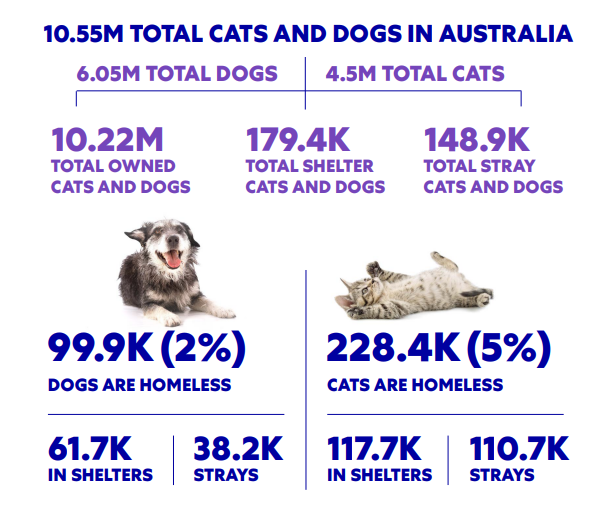Survey reveals reality of stray animal crisis in Australia, globally
January 29, 2024

A lengthy research project has revealed severity of the stray pet crisis in Australia, and globally.
The State of Pet Homelessness Project report has put a spotlight on the staggering number of pets living on the streets or in shelters in 20 countries.
In this post, we break down the statistics, including reasons why the pet homelessness rates are soaring worldwide.
🚨 Spread the word – here’s 5 common pet adoption and rescue myths busted!
New research has revealed just how many stray animals live on the streets, with the staggering statistics highlighting the scale of global pet homelessness.
The research was spearheaded by a coalition of animal welfare experts in partnership with Mars. The group had a shared ambition to end pet homelessness.
‘The State of Pet Homelessness Project’ reveals there’s approximately 362 million homeless pets across 20 countries surveyed.
The findings indicate approximately 35% of cats and dogs live on the streets or in shelters.
That’s about 143 million dogs and 203 million cats on the streets. While approximately 12 million dogs and four million cats in shelters.
The project is the largest international study of its kind and aims to understand the extent of pet homelessness. It also looks at the factors contributing to the issue.
Jeffrey Flocken, President of Humane Society International, stresses the complexity of pet homelessness.
“This new data will help animal welfare organisations, policymakers, pet professionals, academics and researchers to better understand the scale and factors influencing the issue,” Flocken says.
“Which can, in turn, support the most impactful interventions.”


Stray cats in the Middle East (image supplied)
Global pet homelessness crisis
Globally, around 15% of pet owners surveyed say they are considering giving up their pet in the next 12 months.
The data was gathered from over 900 sources, 30,000 public surveys, and 200 expert interviews.
The 20 countries involved are Australia, Brazil, Canada, China, France, Germany, Greece, India, Indonesia, Japan, Lithuania, Mexico, New Zealand, The Philippines, Poland, South Africa, Turkey, Thailand, the USA, and the UK.
While each country has different challenges, the data reveals several common themes across the twenty countries:
🛑 Pet–friendly housing limitations: Almost one in five people who are considering giving up their cat or dog in the near future say it’s because they are moving home and cannot take their pet with them. And almost half of those who have rehomed a pet in the past did so for that reason.
🛑 Personal health challenges: being able to care for a pet longterm is the number one reason globally. Housing related factors come second, and time pressure to be able to look after a pet being the third most common reason. Other factors like behaviour, family allergies and cost also appear in the data.
🛑 Homeless, lost pet population increase: A concerning finding is the high number of pets lost and not reunited with their owners. Almost half of people surveyed had lost a pet, and of those almost 60% were never found.
🛑 Low desexing rates: Additionally, the low sterilisation rates of pets contribute to unplanned litters, exacerbating the homelessness issue. Globally, pet owners report that only about 50% of dogs and 60% of cats are sterilised.
Urgent interventions needed to reduce stray animals crisis: expert
Loïc Moutault, Global President of Mars Petcare, highlights the need for targeted interventions to improve the lives of these pets. Mars aims to support 30 million vulnerable pets over the next five years through various initiatives.
Mars has also donated $500,000 to Humane Society International. That money will fund projects in India, South Africa, and Mexico, focusing on reproduction control, training, and care.
This effort is part of Mars’ ongoing commitment to supporting vulnerable pets globally.
Australian statistics www.stateofpethomelessness.com.
Stray animals in Australia
Reports have been made for all the countries surveyed. Australia’s report highlights the overwhelming number of homeless cats compared to dogs.
The State of Pet Homelessness website says three percent of Australia’s cats and dogs are homeless. This means, there’s roughly 328,ooo homeless pets out of 10.5 million.
While there’s almost 62,000 dogs in shelters across the country, there’s almost double the number of cats – 117,000.
Street cats are also significantly higher than dogs: 110,ooo compared to 38,ooo.
Why are there so many stray pets in Australia?
Australia is a nation of pet lovers, known for our overall responsible pet ownership. But, in recent years we’ve seen just how many stray animals are on the streets.
A number of challenges contribute to this rise in pet homelessness. We’ve listed some of the most crucial challenges, all of which highlight the need for more supportive policies and community initiatives to help pet owners.
💡Rising cost-of-living: The increasing cost-of-living in Australia is a significant concern for pet owners. Expenses such as veterinary care, pet food, and other essentials have seen a notable rise. This increase strains the budgets of many people, making it challenging to provide the necessary care for their pets.
💡Pet-friendly rentals: Finding rental properties that allow pets remains a major hurdle in Australia. Despite pets being a beloved part of many Australian households, a significant number of landlords and rental properties still maintain a ‘no pets’ policy. This restriction often forces pet owners to make the difficult decision to rehome their pets when moving.
💡Limited access to pet care services: In some areas, especially rural and remote regions, access to veterinary services and pet care facilities can be limited.
💡Urbanisation and lifestyle changes: As more Australians move to urban areas, the change in lifestyle can also impact pet ownership. As does smaller living spaces, busy work schedules, and urban environments with limited outdoor space for pets.
💡Breed-specific legislation and restrictions: Certain breeds of dogs are subject to restrictions in various parts of Australia. This legislation can create additional challenges for owners of these breeds.
💡Environmental hazards: Australia’s unique environment also poses specific challenges, such as the threat of wildlife, extreme weather conditions, and the prevalence of ticks and other parasites. Pet owners must be vigilant and proactive in protecting their pets from these environmental hazards.


→ Read our article on how pets have become the latest victim of the global cost-of-living crisis.
How to keep your beloved pet safe….at home
There are a number of items that every pet parent should have to ensure their pets are safe, secure, and don’t end up lost on the streets if they manage to escape.
Obviously, every responsible pet owner should ensure their pets are desexed and microchipped.
For cat owners, there’s growing evidence to support keeping your pets indoors – for both their own safety, and that of local wildlife.
If you want to ensure your pet has the best chance of being found after running away, these items are incredibly important for pet owners:
✔️Pet ID tags
Without a doubt one of the most important items every pet parent needs to purchase is an ID tag for their dog or cat. Every day, animals are found wandering and taken to the local shelter because they don’t have a tag with their owner’s contact details. Having one can save a lot of worry, time, and even money!
✔️GPS pet trackers
GPS trackers can help prevent pets from becoming strays by enabling owners to locate their pets if they go missing.
READ MORE FROM ANIMAL FRIENDLY LIFE
Sign up to raise funds for breast cancer research by dog walking this February
Trees for Pets; unique pet memorial using trees to honour lost pets
